The Membership Challenge: A fan’s journey joining all 17 NRL clubs
26 July 2024
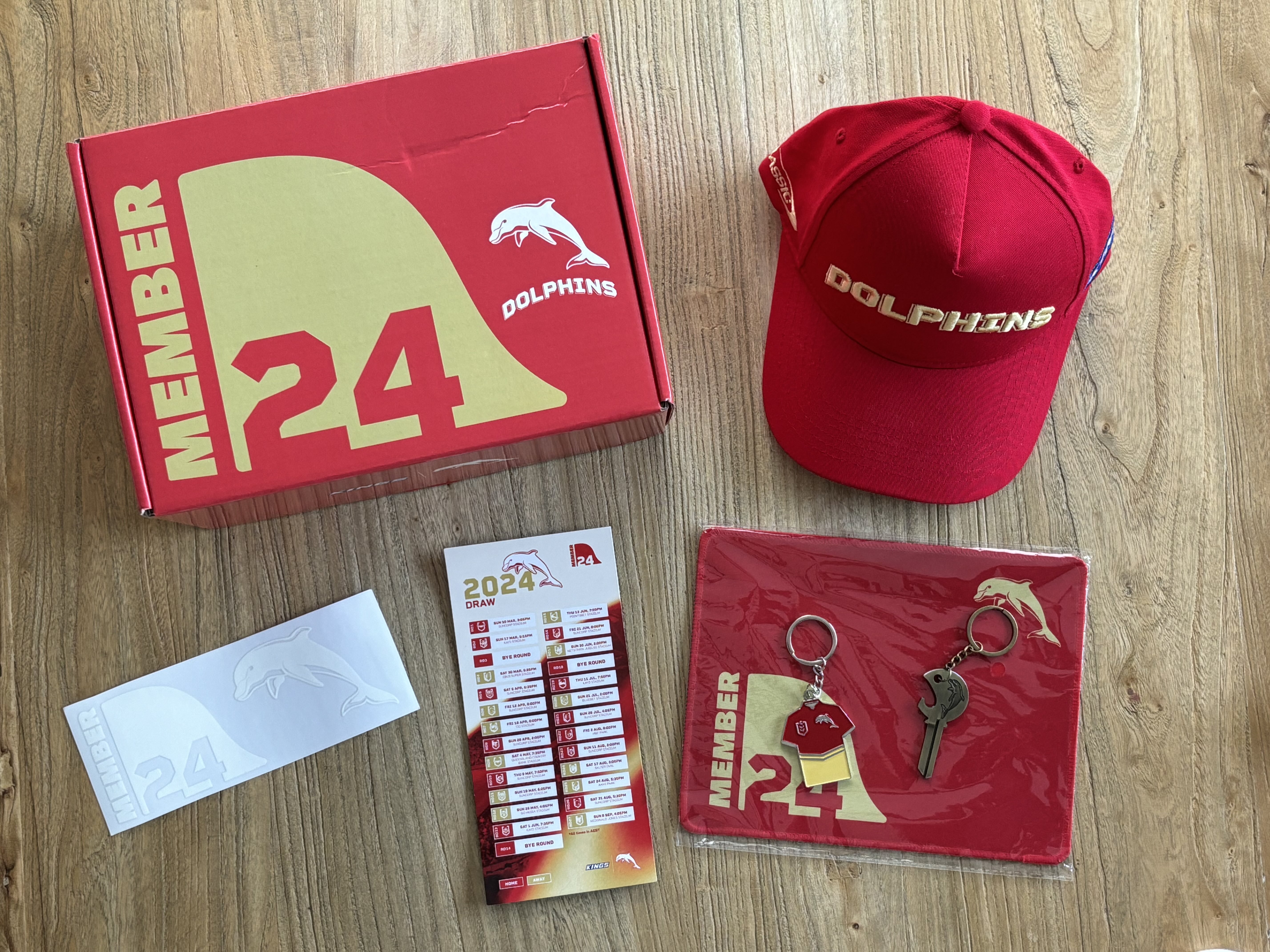
Imagine joining every club in the NRL. How easy is it to sign up? How do the clubs communicate throughout the season? Are you acknowledged and nurtured as a new member? This fan found out.
Recruiting members is a challenge for many organisations in 2024. As Robert Putnam famously observed in his 2000 book, ‘Bowling Alone’, across the West there has been an increasing decline in both paid and voluntary membership.
Organisations that depend on members – from unions and P&Cs, to industry associations and even sporting clubs – are, with some notable exceptions, finding it more difficult than ever to bring new members into their ranks.
There are complex cultural shifts feeding into this trend. Cost of living pressures, less ‘free time’, a declining trust in institutions – to name just a few. However, I’m also convinced that there are gaping holes in the design and delivery of the customer experience of member-based organisations that makes getting and keeping new members harder than it needs to be. I’ve got a unique and compelling case study to illustrate it.
This year I joined every club in the NRL. That’s right – from the Broncos to the Warriors, I am now a card-carrying member of all 17 clubs. I wanted to compare the experience of becoming a member of an NRL club for the first time. How easy is it to sign up? How do the clubs communicate with me throughout the season? Am I acknowledged and nurtured as a new member?
At the start of the 2024 season I spent $1,083, purchased the non-ticketed membership package for each club and documented what happened next. It has been an eye-opening experience that has highlighted the significant opportunities that exist, not only for rugby league clubs but all organisations that depend on a strong and loyal membership.
The state of NRL membership
There are 17 NRL clubs but only 14 report their membership numbers and in the 2023 season these clubs reported a total of 303,878 members, averaging 21,705 members per club. There are some good news stories when it comes to membership figures in the NRL this season. Back in 2011, membership of the Broncos was at around 15,000 but this year they were the first club to break the 50,000 mark. Other clubs including the Raiders, Sharks and Roosters have all broken their previous membership records this year, with the latter achieving 47% growth over the last decade. However, while the season is still in play and the numbers aren’t in yet, reported figures for clubs including Cowboys, Dragons, Storm and Wests Tigers are all on the decline.
A comparison with AFL membership
Seasonal fluctuations aside, the potential for growth for all clubs is evident when these numbers are compared with membership figures of the AFL. In 2023, the AFL announced a new all-time record total of 1,264,952 club members for the season, an average of more than 70,000 members per club. Notably, 15 clubs broke their all-time membership records and three clubs surpassed 100,000 members. Incredibly, 1 in 21 Australians is a member of an AFL club. It is not surprising that AFL clubs have an average membership more than three times that of the NRL and even the NRL’s club with the highest membership (Broncos) has less than half the members of its equivalent in the AFL.
While membership in the NRL is not as deeply ingrained in the sports culture as in the AFL, it is becoming more important for financial stability, fan engagement, and competitive positioning in the sports market. The point of comparing the two codes is to demonstrate the positive – that joining isn’t dead and this willingness to join should be capitalised on by the NRL and other member-based movements.
Comparing the experience across the NRL
Over the last 4 months I’ve carefully documented my membership experience across four categories:
Pre-registration,
Checkout experience,
Membership packs, and
Post-registration
It’s been a fascinating journey with some bright spots amid significant opportunities for improvement.
1. Choosing a membership
There are an average of 17 available membership packages per club – from the Storm (28) to the Warriors (7). With so many packages to choose from it can be confusing to know which one is best suited to your needs.
This is where a ‘Help me choose’ quiz comes in handy. Asking potential members a few questions about their needs can reduce the complexity of choosing a package. Five clubs provided a quiz, including the Broncos:

Sometimes the wording of the packages was confusing. For example, I had to contact the Dolphins to ask what the difference between the Phinatics and the Flippers packages:
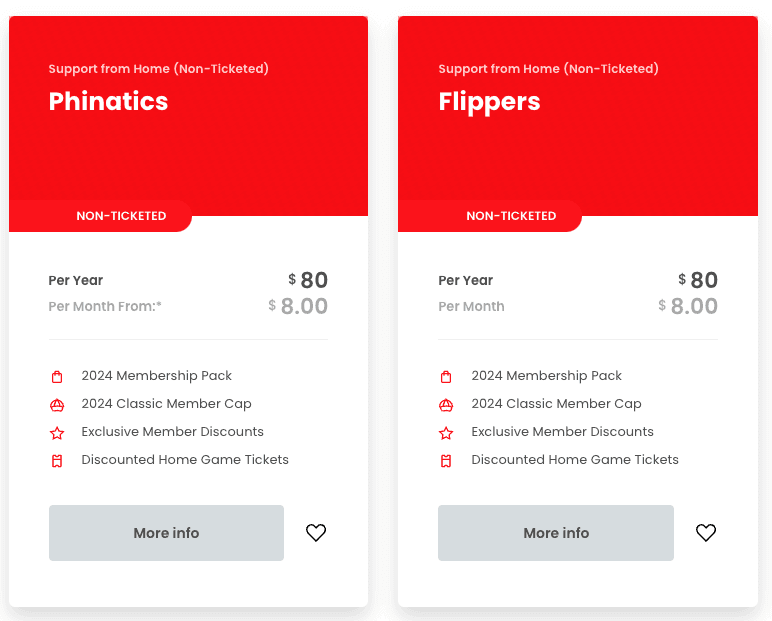
I wanted to clarify if merchandise was provided with Rabbitohs membership because no information was provided on the website. These are just two examples of the kind of questions that people will have before they join – and the need to make it as easy as possible for them to get them answered.
Live chat is an increasingly popular solution for these pre-sales moments because it offers a low friction method of engagement. Compellingly, website visitors who engage in live chat are 2.8 times more likely to convert than those who don’t. However, only three clubs (Dolphins, Knights, Roosters) offered this on their website.
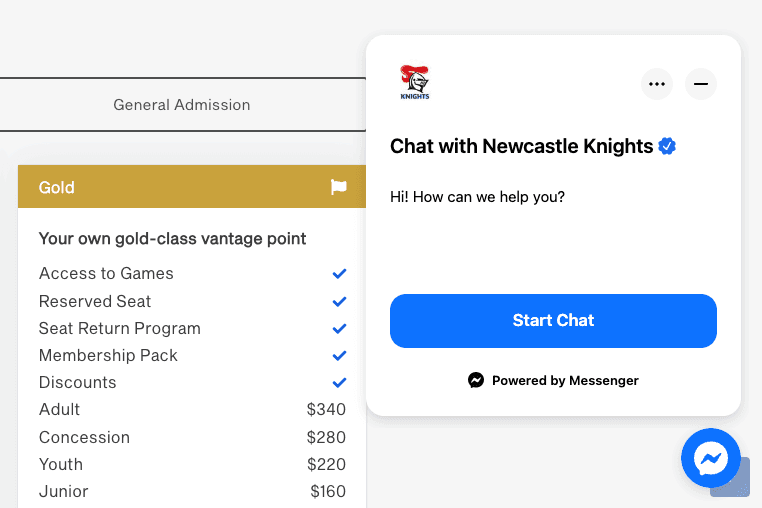
2. Checkout process
I signed up for each club’s non-ticketed membership category, which was an option for every club except the Penrith Panthers. These ranged in price from $34 (Storm) to $120 (Rabbitohs), with an average cost of $67.
Only two clubs (Cowboys and Dolphins) promoted gift memberships while three other clubs (Panthers, Roosters and Titans) asked if I was purchasing the membership for someone else. Curiously, very few questions were asked during the checkout process to learn more about me, their new member. Two clubs asked for my Twitter handle (Bulldogs and Dragons):
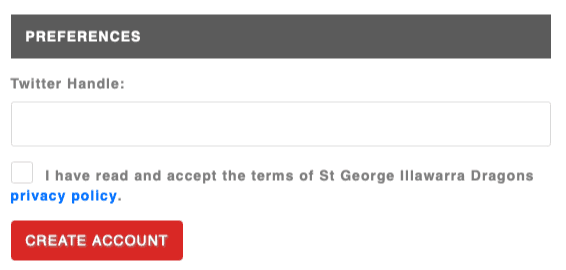
The Cowboys and Tigers asked who my favourite player is:
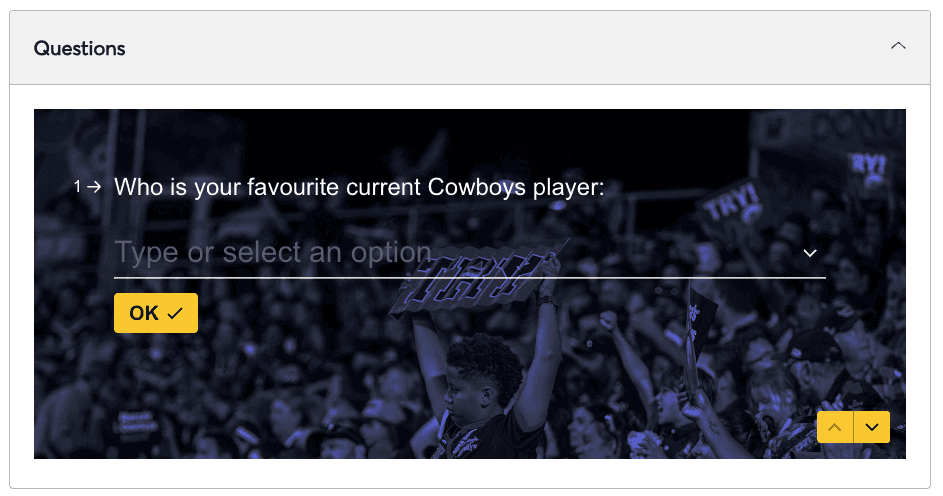
Four clubs asked for my date of birth (Dragons, Knights, Rabbitohs and Tigers). I haven’t had my birthday yet so I’m yet to see what they will do when that date rolls around.
Given the value of word of mouth for promoting membership, I was surprised that only three clubs wanted to know who had encouraged me to join. The Sharks and Tigers asked for a name:

While the Storm only wanted to know which member of staff had encouraged me to join:

It was annoying that three clubs (Cowboys, Dolphins and Roosters) provided no option but to automatically renew my membership for the next season. While this might be convenient for long term members who want to pay once and not think about it again, it’s a bit presumptuous for people who are joining for the first time.
Another point of frustration was the additional cost. Three clubs (Bulldogs, Dragons and Tigers) added an extra fee of $4.75 at checkout. Again, this is a bit cheeky (what exactly am I paying for here?) and left a bad taste in my mouth.
3. Membership packs
From stickers and the classic stubbie holder to lanyards and the less conventional laptop case, a diverse collection of club merchandise dripped into my letterbox in the weeks after joining. It took on average 10 days for merch to arrive and only one club (Knights) required following up for a non-show pack.
The impressively branded boxes that contained merch from the Dolphins, Sea Eagles and Dragons left their mark, as did the lack of merch from Rabbitohs who coincidentally also had the most expensive non-ticketed package. Store credit of $20 was provided with my membership, but this wasn’t enough to purchase most items from the store let alone the shipping.
4. Post-registration
There isn’t enough space here to share about how the clubs engaged (or didn’t) with me in the days, weeks and months after joining, but let me share three observations:
Only 10 clubs sent me a welcome email when I joined.
Only 6 clubs (to date) have surveyed me about my membership experience.
3 clubs haven’t communicated with me at all since I joined.
The biggest surprise was that no club acknowledged me as a first time member. No welcome videos from the captain, signed notes from the coach or even a simple ‘Thanks for joining for the first time’ email. Instead, I received a lot of ‘welcome back to season 2024’ emails that were presumably sent to every other member. I felt like just a number – precisely what you don’t want members (and especially new members) feeling.
This level of personalisation might seem like a lot of effort – and compared to generic communication it is – but the intentional onboarding of new members should be a high priority for organisations that depend on members to survive and thrive. Joining an organisation for the first time is a big step. It’s also a moment when small details are noticed and initial impressions are forged. What happens in the first hours and across the first season can shape the likelihood of future memberships with lifetime value in the thousands or even tens of thousands of dollars.
Conclusion
I’m passionate about the role of customer experience in fuelling brand loyalty and organic growth. Four years ago I approached my superannuation fund with suggestions for how to improve the experience for new members. The website was complicated. The sign-up process was confusing. You really needed to be committed to the process of joining because you needed to jump multiple obstacles along the way. But when I met with the head of member experience I was told that they were happy with their progress and were hitting their annual targets. Today, that super fund no longer exists.
NRL clubs and other member-based organisations may not face the same existential challenges, but they cannot be complacent. There is fierce competition for attention and loyalty and it’s not going away. Generic, haphazard engagement simply won’t cut it.
Delivering real-time support. Getting to know your members. Personalising engagement. Leveraging word-of-mouth referrals. Communicating across channels aligned with customer preferences. None of these require a huge spend (and not when compared with the costs of acquiring new members) but together they provide valuable fan insights and long-term opportunities. Intentionality is an investment that pays off for many seasons.
I’ve reached out to clubs with these recommendations – I’m looking forward to seeing what’s different in season 2025.
—
This is Part 1 of the NRL membership experiment. Read Part 2 - Inside the NRL's Member Communication: A 17-Club Analysis.
